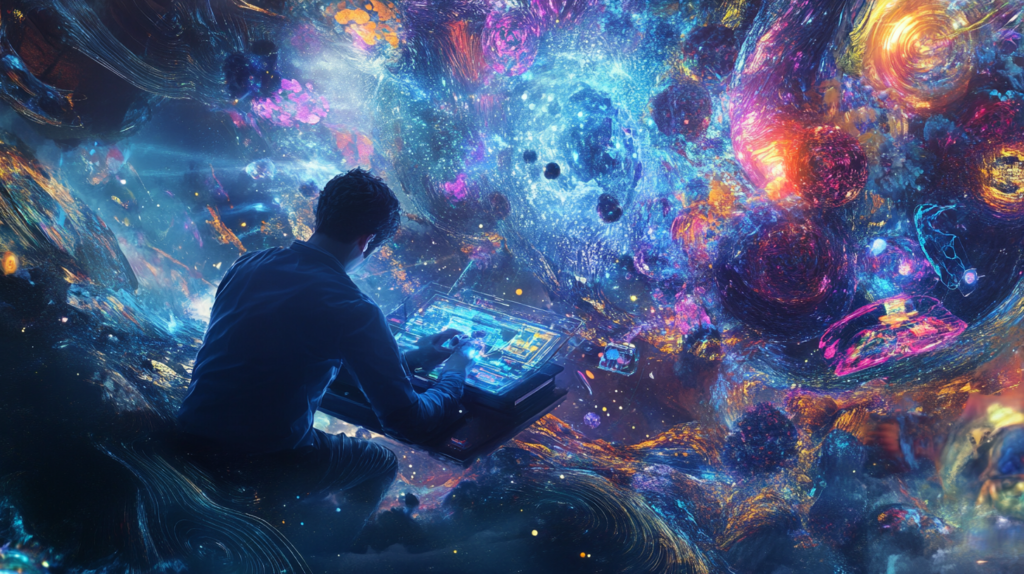
In a world where multiple universes seem to be the norm, crafting interfaces for a singular reality feels almost quaint. Welcome to the era of Interdimensional UX Design, where the boundaries of space, time, and dimensionality blur, challenging designers to cater not just to a global audience but to a multiversal one. It’s a brave new world—or worlds, rather—where the principles of good design transcend mere accessibility and usability, delving into the fabric of reality itself.
Interdimensional UX Design isn’t just a whimsical idea for sci-fi enthusiasts. With the advent of virtual reality (VR), augmented reality (AR), and mixed reality (MR), digital experiences are beginning to spill over into multiple layers of existence. It’s no longer enough to design for a flat screen. Today’s UX professionals are tasked with creating immersive experiences that seamlessly integrate with users’ perceptions of both the real and the virtual, embodying the essence of Multireality User Experience.
How does one even begin to approach design for multiple realities? First, it’s crucial to understand the context of each dimension. A user interacting with an application in a fully immersive VR environment requires a different approach than one engaging with AR overlays on the physical world. The former demands a complete creation of space and interaction within it, while the latter augments existing reality, necessitating a delicate balance that enhances without overwhelming.
Accessibility takes on a whole new meaning in Interdimensional UX Design. It’s about more than color contrasts or font sizes (though those remain important). Now, it’s about ensuring that experiences are accessible across different planes of reality. Can a user seamlessly transition from a 2D website to a 3D virtual environment? Is the experience as intuitive in an AR-enhanced physical space as it is on a traditional screen? These are the questions that keep Multireality User Experience designers up at night.
Then there’s the challenge of narrative. Every design tells a story, but Interdimensional UX Design requires narratives that adapt and evolve across realities. A user’s journey through a VR game, an AR shopping experience, and a mobile app should feel cohesive, with each environment contributing to a unified narrative thread. Achieving this level of storytelling finesse requires not just technical skill, but a deep understanding of narrative structures and user psychology.
Of course, with great power comes great responsibility. The ethical implications of designing for multiple realities cannot be overstated. As designers, we have the power to shape not just how users interact with digital environments, but how they perceive reality itself. This means considering the psychological impact of our designs, ensuring they promote healthy engagement and respect users’ autonomy and privacy.
Collaboration is key in this multidimensional endeavor. UX designers can no longer afford to work in silos, focused solely on their niche. Interdimensional UX Design demands a cross-disciplinary approach, bringing together experts in psychology, storytelling, spatial design, and technology. It’s a team sport, and everyone—from the coder to the copywriter—plays a crucial role in creating cohesive experiences across dimensions.
Let’s not forget the role of technology. Advances in AI, machine learning, and spatial computing are the engines driving this shift toward Interdimensional UX Design. They’re not just tools but collaborators in the design process, enabling us to create experiences that were once the stuff of science fiction. However, as we push the boundaries of what’s possible, we must also remain grounded in the needs and limitations of our users. After all, the most technologically advanced design is worthless if it doesn’t resonate on a human level.
So, where does this leave us? On the cusp of a revolution, certainly. Designing for multiple realities offers an unprecedented opportunity to redefine what it means to connect with users. It challenges us to think bigger, to envision a world (or worlds) where digital experiences are not just seen or touched, but fully lived. It’s an exciting, daunting task, but as history has shown, UX designers are nothing if not adaptable.
As we stand on the brink of this new frontier, it’s clear that Interdimensional UX Design isn’t just about designing for different realities—it’s about creating experiences that enrich our understanding of what it means to be human. Whether we’re crafting a VR space odyssey or an AR-enhanced museum tour, the goal remains the same: to connect, to engage, and to inspire.
The journey into Interdimensional UX Design is not for the faint-hearted. It demands a blend of creativity, technical prowess, and ethical consideration like never before. But for those willing to take the leap, the possibilities are as limitless as the realities we seek to design for. After all, in a multiverse of endless possibilities, why settle for designing in just one?


